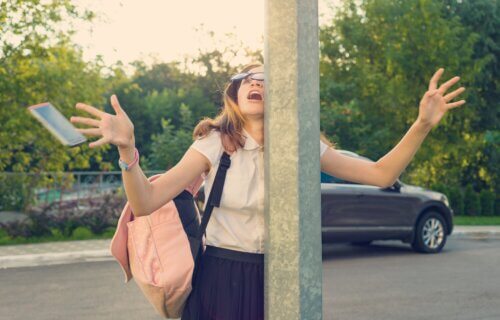KENSINGTON, Australia — Young people are more likely to stumble and fall when texting while walking, according to a new study. Along with the potential for an accident, researchers in Australia also show that the quality of text messages is not as good when college-aged young adults are typing while on the move. Simply put, if young people text and walk, they’re more likely to make a typo before tripping over something.
Until now, experts have been divided over whether texting while walking increases the risk of an accident for young adults engrossed in their smartphones. Some studies have shown that texting pedestrians are more likely to walk into oncoming traffic, while other research suggests that young adults have mastered multitasking and can text accurately while navigating obstacles. However, few studies have previously measured how texters respond to unpredictable hazards.
In a recent experiment, Australian scientists simulated an environment with random slipping threats, demonstrating that texting does indeed increase the risk of falling in response to walkway hazards.
“On any day it seems as many as 80% of people, both younger and older, may be head down and texting. I wondered: is this safe?” says senior author Matthew A. Brodie, a neuroscientist and engineer at the University of New South Wales (UNSW) Graduate School of Biomedical Engineering, in a media release. “This has made me want to investigate the dangers of texting while walking. I wanted to know if these dangers are real or imagined and to measure the risk in a repeatable way.”
The researchers recruited 50 UNSW undergraduate students for the experiment. Dr. Brodie and co-author Dr. Yoshiro Okubo created a tiled hazard walkway at Neuroscience Research Australia’s gait laboratory, featuring a tile that could slide out of place, causing anyone who stepped on it to slip as if it was a banana peel.
The participating students wore safety harnesses and motion sensors to prevent falls and collect data. They were asked to traverse the walkway either without texting or while typing “The quick brown fox jumps over the lazy dog.” The uncertainty of real life was simulated by only informing students that they might or might not slip, allowing the researchers to study how texting pedestrians might anticipate and attempt to prevent a potential slip.
“What surprised me is how differently people responded to the threat of slipping,” says Brodie. “Some slowed down and took a more cautious approach. Others sped up in anticipation of slipping. Such different approaches reinforce how no two people are the same, and to better prevent accidents from texting while walking, multiple strategies may be needed.”

Despite motion data showing that texting participants attempted to be more cautious, Dr. Brodie stated that it did not reduce their risk of falling. When participants went from leaning forward to slipping backward, their motion sensors detected an increase in the range of their “trunk angle.” This data was used to measure whether texting made students more prone to falling, and the findings revealed that the average trunk angle range during a fall significantly increased if a student was texting.
The research also found that walking decreased the texters’ accuracy, as reported in the journal Heliyon.
Dr. Brodie further explained that the highest texting accuracy occurred when participants were seated. Even when walking participants were warned about a potential slip that did not happen, accuracy decreased. The lowest accuracy occurred when participants did slip.
The research team noted that young people might be more prone to take risks, even if aware that texting and walking could increase their likelihood of falling. Therefore, they believe that educational initiatives like signs might be less effective.
The researchers are also suggesting that phones could implement locking technology, similar to what is used when users are driving. Dr. Brodie believes that this technology could detect walking activity and activate a screen lock to prevent texting during that time.
South West News Service writer Stephen Beech contributed to this report.

